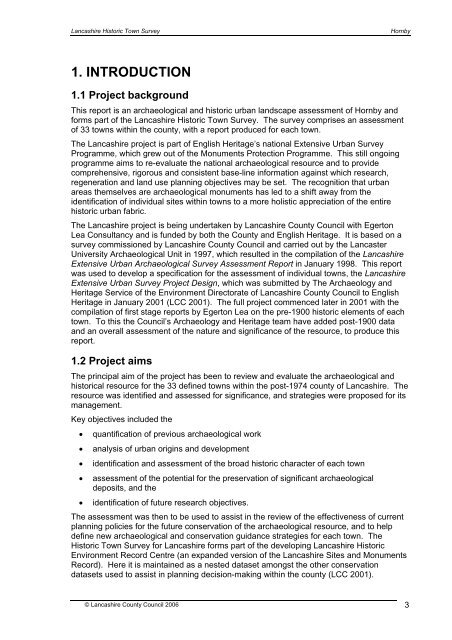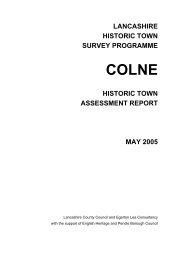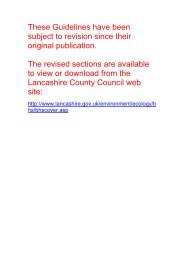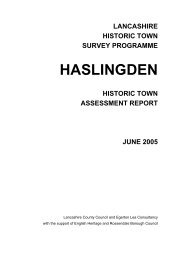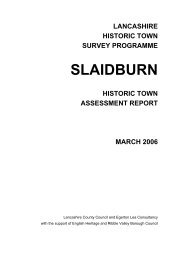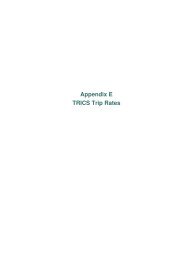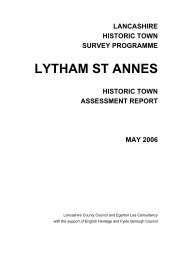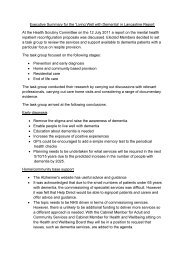HORNBY - Lancashire County Council
HORNBY - Lancashire County Council
HORNBY - Lancashire County Council
Create successful ePaper yourself
Turn your PDF publications into a flip-book with our unique Google optimized e-Paper software.
<strong>Lancashire</strong> Historic Town SurveyHornby1. INTRODUCTION1.1 Project backgroundThis report is an archaeological and historic urban landscape assessment of Hornby andforms part of the <strong>Lancashire</strong> Historic Town Survey. The survey comprises an assessmentof 33 towns within the county, with a report produced for each town.The <strong>Lancashire</strong> project is part of English Heritage’s national Extensive Urban SurveyProgramme, which grew out of the Monuments Protection Programme. This still ongoingprogramme aims to re-evaluate the national archaeological resource and to providecomprehensive, rigorous and consistent base-line information against which research,regeneration and land use planning objectives may be set. The recognition that urbanareas themselves are archaeological monuments has led to a shift away from theidentification of individual sites within towns to a more holistic appreciation of the entirehistoric urban fabric.The <strong>Lancashire</strong> project is being undertaken by <strong>Lancashire</strong> <strong>County</strong> <strong>Council</strong> with EgertonLea Consultancy and is funded by both the <strong>County</strong> and English Heritage. It is based on asurvey commissioned by <strong>Lancashire</strong> <strong>County</strong> <strong>Council</strong> and carried out by the LancasterUniversity Archaeological Unit in 1997, which resulted in the compilation of the <strong>Lancashire</strong>Extensive Urban Archaeological Survey Assessment Report in January 1998. This reportwas used to develop a specification for the assessment of individual towns, the <strong>Lancashire</strong>Extensive Urban Survey Project Design, which was submitted by The Archaeology andHeritage Service of the Environment Directorate of <strong>Lancashire</strong> <strong>County</strong> <strong>Council</strong> to EnglishHeritage in January 2001 (LCC 2001). The full project commenced later in 2001 with thecompilation of first stage reports by Egerton Lea on the pre-1900 historic elements of eachtown. To this the <strong>Council</strong>’s Archaeology and Heritage team have added post-1900 dataand an overall assessment of the nature and significance of the resource, to produce thisreport.1.2 Project aimsThe principal aim of the project has been to review and evaluate the archaeological andhistorical resource for the 33 defined towns within the post-1974 county of <strong>Lancashire</strong>. Theresource was identified and assessed for significance, and strategies were proposed for itsmanagement.Key objectives included the• quantification of previous archaeological work• analysis of urban origins and development• identification and assessment of the broad historic character of each town• assessment of the potential for the preservation of significant archaeologicaldeposits, and the• identification of future research objectives.The assessment was then to be used to assist in the review of the effectiveness of currentplanning policies for the future conservation of the archaeological resource, and to helpdefine new archaeological and conservation guidance strategies for each town. TheHistoric Town Survey for <strong>Lancashire</strong> forms part of the developing <strong>Lancashire</strong> HistoricEnvironment Record Centre (an expanded version of the <strong>Lancashire</strong> Sites and MonumentsRecord). Here it is maintained as a nested dataset amongst the other conservationdatasets used to assist in planning decision-making within the county (LCC 2001).© <strong>Lancashire</strong> <strong>County</strong> <strong>Council</strong> 2006 3


